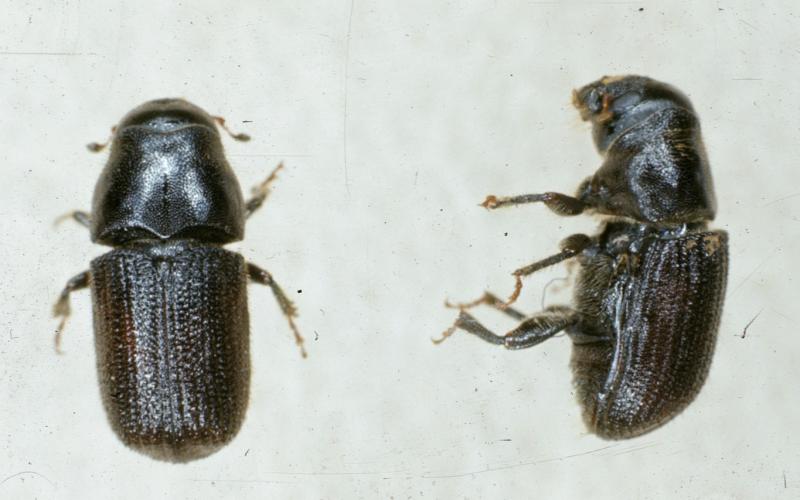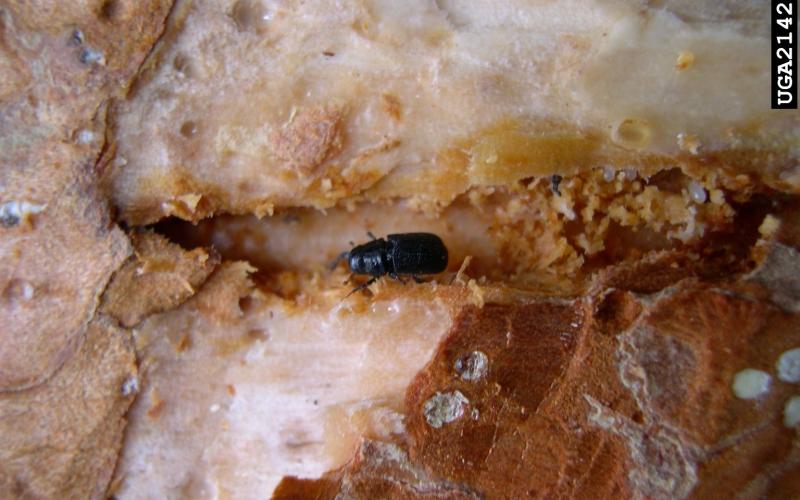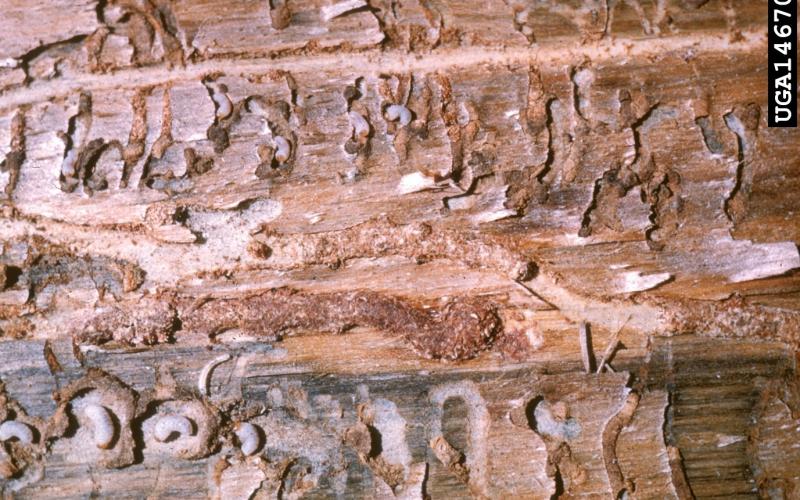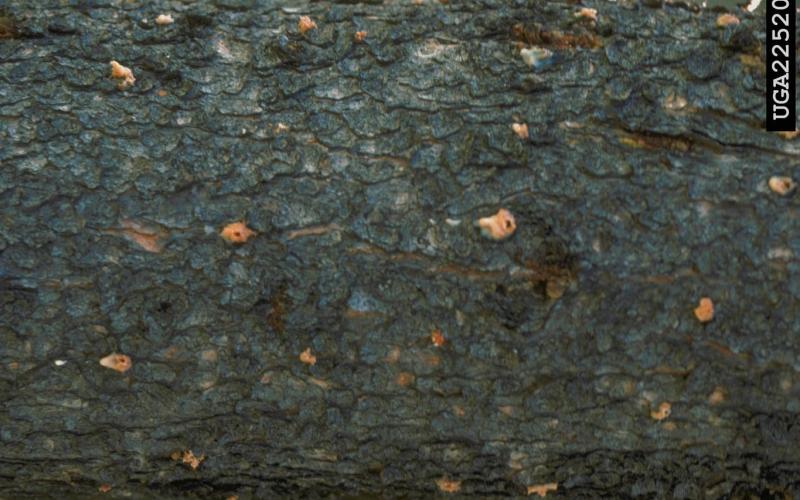Native range: Mountain pine beetle is native to western North America, Canada and Northern Mexico.
At Risk
Mountain pine beetle attacks and develops within pine trees (genus Pinus). Mountain pine beetle threatens 22 species of pine in North America. Lodgepole pine (Pinus contorta) is mountain pine beetle’s primary host in the west. Nearly all species of Pinus are susceptible to mountain pine beetle. Jeffery pine (Pinus jeffreyi) is the only species that has shown some level of resistance.
In Minnesota, there are approximately one million acres of pine trees, consisting of three native species: eastern white, jack, and red (Norway) pine. In terms of volume, Red (Norway) pine is Minnesota’s second most common tree overall. We also have many non-native pine trees commonly found in urban areas such as ponderosa, Austrian, and scots (scotch).
Minnesota’s forest industry is the state’s fourth largest manufacturing sector, valued at $7 billion, and employs more than 90,000 people. Minnesota’s urban community forests are valued at $760 million. The potential impacts mountain pine beetle poses to Minnesota are many. Mountain pine beetle will negatively affect many industries, such as lumber and tourism. Harmful ecological effects will likely result, such as: changes to the carbon cycle, water resources, water runoff regulation, altered forest succession, habitat destruction, and displacement of many species. Mountain pine beetle will also increase the threat of wildfire, and the hazard of falling dead trees.
Individuals and companies which rely on forest product materials may be affected by mountain pine beetle. Residents with pine on or near their property have the potential to be affected by mountain pine beetle. Damage to the ecosystem can affect us all in many ways, including reduced tourism, another major industry in Minnesota. We should all be concerned about this threat to our state.
 United States map showing the pathways by which mountain pine beetle may enter Minnesota. Map created by D. Rosenberger, R. Venette, and B. Aukema, University of Minnesota. |
Distribution
Mountain pine beetle is native to western North America, where periodic outbreaks are a normal part of its ecology. However, in recent years, mountain pine beetle has experienced the largest population explosion ever recorded and has caused the mortality of approximately 125 million acres of coniferous forest in North America. Mountain pine beetle is currently causing tree mortality as far eastward as the Black Hills National Forest in South Dakota and Alberta, Canada. There is concern that mountain pine beetle may reach our Minnesota forests and cause similar devastation.
The MDA has documented two separate occasions in which mountain pine beetle-infested wood has been imported into Minnesota (once in 2012 and again in 2014). These beetles were already dead in both cases. Moving pine wood with bark from a location with mountain pine beetle to one without mountain pine beetle is one way this devastating pest of pine could be spread to our state.
Biology
Mountain pine beetle adults emerge from their host tree in mid-to-late summer. The new adult females seek out suitable host trees. Once a female beetle has found a suitable host, she burrows directly into the tree through the bark, and releases pheromones which attract other mountain pine beetles to the same tree. These beetles also bore into the tree and produce their own pheromones, attracting even more beetles, which results in a mass attack that overcomes the tree’s defenses. A female lays eggs in late summer. Each egg produces one larva which tunnels away from its mother’s gallery under the bark. These larval beetles continue feeding over the winter through spring. They pupate mid-summer and become adults. Adults emerge and attack new trees, resuming the cycle.
Adult mountain pine beetles bring harmful fungi with them when they enter a tree. These fungi have a symbiotic relationship with the beetles, and disrupt the tree’s nutrient and defense systems. The “blue stain” associated with trees killed by mountain pine beetles is the result of these fungi.
Identification
Mountain pine beetle is a very small insect. As an adult, mountain pine beetles are only about 5mm (3/16”) in length. To the untrained eye, nearly any beetle within the taxonomic family of mountain pine beetle (Scolytidae) may be mistaken for a mountain pine beetle. There are approximately 500 species of scolytid beetles in the United States alone. In addition, most of the mountain pine beetle’s life is spent unseen under the bark of a pine tree and it is only during a relatively short flight period in the summer months that a living adult be seen.
Damage caused by mountain pine beetle is more readily observable than the insect itself. As a mountain pine beetle enters a tree, the tree responds defensively by attempting to pitch the beetle out. This defensive response produces a popcorn-like protuberance called a “pitch tube” on the exterior of the trunk. A pitch tube is tree resin that’s extruded from the mountain pine beetle’s entry point, or attempted entry point, and can be brown, pink, or white. Red boring dust (similar to fine sawdust) will commonly be present in bark crevices and around the base of the tree.
Evidence of woodpecker feeding, such as missing patches of bark, may also indicate mountain pine beetle. Yellow-to-red discoloration of foliage throughout the tree crown typically occurs the summer following a successful mountain pine beetle attack.
Look-Alikes
- Native engraver beetle damage will also cause the foliage of trees to discolor/fade but this will typically occur within a few months of attack, instead of a full year. The tree’s foliage may start to discolor/fade from the top downward. Boring dust may also be present, but pitch tubes are typically absent.
- Red turpentine beetle will also create large popcorn-like pitch tubes, but these are typically reddish in color and confined to the lower six feet of the tree trunk.
Pest Status: Regulated
The MDA implemented an exterior state quarantine for mountain pine beetle on January 1, 2015. This quarantine prohibits the movement of any pine wood with bark into the state of Minnesota from states with mountain pine beetle. This quarantine is designed to stop the movement into Minnesota of any wood potentially infested with mountain pine beetle. Individuals, businesses or other entities who feel that these regulations could affect them are encouraged to review the quarantine language.
What Can I Do?
This is an insect that we don’t want in Minnesota. Although it is possible that mountain pine beetle will someday reach Minnesota on its own via natural spread through Canada, this is not a certainty. Efforts should focus on ensuring that it is not introduced here through the movement of infested pine logs.
If you think you have a pine tree infested with mountain pine beetle, please visit our Report a Pest page to report the finding to the MDA.
Smarty Plants Podcast

Discover Smarty Plants, the Minnesota Department of Agriculture's podcast that digs into the fascinating world of invasive species. Join expert guests as they share insights and solutions to protect our environment and agricultural resources. Visit Smarty Plants and start listening today.





